Shala K. Howell's Blog, page 6
April 20, 2021
Wordless Wednesday: Flowering cacti
Still waiting on that rain, but wandered across this eye-popping display in a neighbor’s garden.
 This neighbor is really upping the game when it comes to maintaining a succulent garden. Who knew cacti grew giant white flowers like that? That bird on the faded orange fire hydrant in back is a scrub jay, by the way. (Photo: Shala Howell)
This neighbor is really upping the game when it comes to maintaining a succulent garden. Who knew cacti grew giant white flowers like that? That bird on the faded orange fire hydrant in back is a scrub jay, by the way. (Photo: Shala Howell)Their prickly pear isn’t the largest one I’ve seen on my walks though. The thought of pruning this one gives me nightmares. (How do you trim a cactus?)
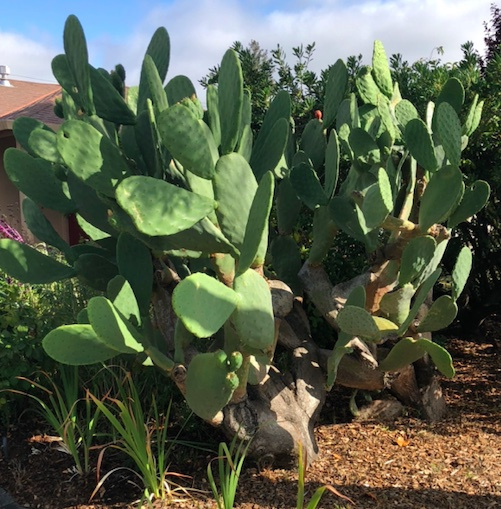 This sucker is taller than the single-story house behind it. (Photo: Shala Howell)
This sucker is taller than the single-story house behind it. (Photo: Shala Howell)I mean, its base is basically a tree trunk. Just look at that.
 There is no doubt in my mind that if Samuel Whiskers were ever to move to California, he and Anna Maria would shack up here.
There is no doubt in my mind that if Samuel Whiskers were ever to move to California, he and Anna Maria would shack up here. Related Links:
More Wordless Wednesdays on Caterpickles “How do you trim a cactus?” (Caterpickles)The Tale of Samuel Whiskers, or the Roly-Poly Pudding by Beatrix Potter (Project Gutenberg)March 31, 2021
Palo Alto Public Art Project: Lost in My Abstract Garden on California Avenue
Title: Lost in My Abstract Garden, 2021
Artist: Carrie Lederer
Location: 155 California Ave, Palo Alto, CA
Photo Source: Me
The 2021 Palo Alto Public Art ProjectAs I mentioned in my last post, Palo Alto has installed eight new temporary murals designed to give residents and businesses struggling with the pandemic a bit of a boost this spring. Last week, I visited the murals along California Avenue, and found myself spending a great deal of time with Carrie Lederer’s Lost in My Abstract Garden.
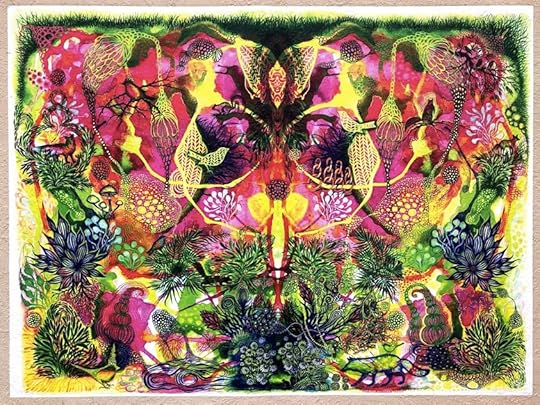 Lost in My Abstract Garden (c) 2021 Carrie Lederer (Photo: Shala Howell)About the Artist
Lost in My Abstract Garden (c) 2021 Carrie Lederer (Photo: Shala Howell)About the ArtistOakland-based Carrie Lederer is a painter, sculptor, and installation artist. In her work, she uses fractals and other patterns found in chaos theory to create abstract, apparently chaotic images that reconstruct the delicate, minute, and thoroughly intertwined natural systems that often go unnoticed in the world around us.
Lederer uses all sorts of manmade materials, including fabric, fur, flock, glass eyes, and glitter, in her work. She also makes frequent use of stencils to impose familiar patterns on the abstracted birds, animals, flowers, and other natural shapes that make up her dense, tapestry-like images.
You can find more of Lederer’s work at Turtle Bay Museum, de Rosa Center for Contemporary Art, San Jose Institute of Art, and UCSF Medical Center. She also has an extensive portfolio on her website.
If you visit her website, be certain to stop by her In the Studio section. The brief captions that accompany each photo offer an intriguing glimpse of Lederer’s process–how she gathers inspiration from raw materials gleaned from her garden, how her hands ache after a long afternoon spent cutting paper stencils, and how she juggles several different projects at once.
You can find Carrie Lederer:
On Instagram: https://www.instagram.com/carrieledererOn Facebook: https://www.facebook.com/carrie.ledererOn her website: https://www.carrielederer.com/A few of my favorite things from Lost in My Abstract GardenI take long walks about four days a week now, winding my way through my neighborhood inspecting my neighbor’s gardens for new blooms and their bird feeders for new-to-me species and old friends. So I suppose it should come as no surprise that when faced with Lederer’s mural I immediately began hunting for the birds. I looked for them at first simply because I like birds. But in writing this up, I realized that my little bird photos are actually reasonable illustrations of how Lederer’s art combines natural forms with abstracted shapes and patterns.
Bird on red Portion of Lost in My Abstract Garden (c) 2021 Carrie Lederer. (Photo: Shala Howell)Bird on green
Portion of Lost in My Abstract Garden (c) 2021 Carrie Lederer. (Photo: Shala Howell)Bird on green
 Portion of Lost in My Abstract Garden (c) 2021 Carrie Lederer. (Photo: Shala Howell)Bird on a fox
Portion of Lost in My Abstract Garden (c) 2021 Carrie Lederer. (Photo: Shala Howell)Bird on a fox
 Portion of Lost in My Abstract Garden (c) 2021 Carrie Lederer. (Photo: Shala Howell)Bird on a blogger
Portion of Lost in My Abstract Garden (c) 2021 Carrie Lederer. (Photo: Shala Howell)Bird on a blogger
 There’s something different about looking at public art in a pandemic. I can’t quite put my finger on it. (Photo: Shala Howell. Art: Portion of Lost in My Abstract Garden, a mural by Carrie Lederer, 2021.)
There’s something different about looking at public art in a pandemic. I can’t quite put my finger on it. (Photo: Shala Howell. Art: Portion of Lost in My Abstract Garden, a mural by Carrie Lederer, 2021.)These obviously aren’t all of the birds in the garden. I couldn’t possibly show you all of them. Where’s the fun in that?
Want to see the new Palo Alto murals for yourself?In the meantime, if you’d like to tour the works yourself, you can find an interactive map listing the murals installed so far here.
Want to go, but need help selling it to your kids?The fact that public art is installed in public spaces creates all sorts of opportunities for family fun. Pack a picnic lunch, a kite or a frisbee, a family-sized supply of masks and hand sanitizer, and pair the outing with a trip to a nearby park or playground. If you have one, consider bringing your dog.
Don’t have time for a full-fledged outing? Challenge your kids to keep their eyes open while you are out and about doing something else. I bet they (or you) will spot something interesting on your next walk, bike ride, or errand run.
My book, What’s That, Mom?: How to use public art to engage your children with the world around them… without being an artist yourself, provides 15 accessible, practical strategies for using public art to spark conversations with children between the ages of 3 and 10 — no artistic talent or insight required.

What’s That, Mom? is available at Bookshop.org and Amazon. There’s even a journal to go with it so that your kids can sketch their favorite works of art and you can record your favorite moments from your outing.
NOTE: This section contains affiliate links to Bookshop.org, an online bookstore that provides financial support to local, independent bookstores. At the time I wrote this post, Bookshop.org had already raised $12.8m for local bookstores. If you use the link in the previous paragraph to purchase my book on Bookshop.org, I’ll earn a commission on your book purchase, as will your preferred independent bookshop. You can also find my book in the new Caterpickles Bookstore. Regardless of whether you use my links or visit the Caterpickles Bookstore, thank you for spending part of your day reading Caterpickles. Learn more about Affiliate Links, the Caterpickles Bookstore, and why I decided to become a Bookshop.org Affiliate.
Happy public art hunting!Related Links:
Carrie Lederer’s websiteThe Palo Alto Public Art Program A compendium of posts on the The Dedham Public Art Project, the public art project that originally inspired What’s That, Mom? (Caterpickles)More Caterpickles posts on public art installations around the countryMarch 19, 2021
The Palo Alto Public Art Project is helping us remember how to be in public spaces again
NOTE: This post contains affiliate links to Bookshop.org, an online bookstore that provides financial support to local, independent bookstores. At the time I wrote this post, Bookshop.org had already raised $12.5m for local bookstores. If you use the link in this post to purchase my book on Bookshop.org, I’ll earn a commission on your book purchase, as will your preferred independent bookshop. You can also find my book in the new Caterpickles Bookstore. Regardless of whether you use my links or visit the Caterpickles Bookstore, thank you for spending part of your day reading Caterpickles.Learn more about Affiliate Links, the Caterpickles Bookstore, and why I decided to become a Bookshop.org Affiliate.
Santa Clara County moved into the red tier earlier this month, which means things are slowly opening up in our area. Retail stores, restaurants, movie theaters, zoos, aquariums, and even some gyms are open for limited indoor use again.
I don’t know about you, but after a year of curbside pickup, virtual meet-ups, and outdoor activities designed to avoid other people as much as possible, I’m a little worried that my family has forgotten how to function in public spaces near other people. We aren’t vaccinated yet, so for now, I pretty much only want us to remember how to wander around outside in areas that have more human pedestrians than feathered or furry ones.
The folks at the Palo Alto Public Art Project have clearly been laser-focused on meeting my personal needs, because last week they announced a new temporary public art project that is absolutely perfect for this.
The 2021 Palo Alto Public Art ProjectPalo Alto has installed eight new temporary murals designed to give residents struggling with the pandemic a bit of an emotional boost this spring.
The murals, all of which were designed by local artists, dot two of Palo Alto’s commercial corridors: University Avenue in downtown, and California Avenue, where we used to spend our Sunday mornings browsing the weekly Farmers’ Market. In the University area, you’ll find works by t.w.five, Robin Apple, Lauren Berger, and Katherine Liu. California Ave, which we toured this week, is home to murals by Jorge Camacho, Damon Belanger, Liz Hickock, and Carrie Lederer as well as a truly impressive variety of outdoor dining spaces for the street’s various restaurants.
The murals are billed as a temporary installation, but honestly, the fact that the murals will remain in place for at least a year makes me wonder if the pandemic has broken time as badly for the folks at the Palo Alto Public Art Program as it has for me. This remains the longest March ever.
I’ll have lots more to say about the Palo Alto Public Art Project in coming weeks. With our county slowly resuming economic and social activities, this installation is a great opportunity to get my entire family used to roaming freely around the world again. Also, I like writing about this sort of thing.
 There’s something different about looking at public art in a pandemic. I can’t quite put my finger on it. (Photo: Shala Howell. Art: Portion of Lost in My Abstract Garden, a mural by Carrie Lederer, 2021.)Want to see the murals for yourself?
There’s something different about looking at public art in a pandemic. I can’t quite put my finger on it. (Photo: Shala Howell. Art: Portion of Lost in My Abstract Garden, a mural by Carrie Lederer, 2021.)Want to see the murals for yourself? In the meantime, if you’d like to tour the works yourself, you can find an interactive map listing the murals installed so far here.
Did you know that I’ve got a book out about how parents can use public art to engage their children with the world around them?

What’s That, Mom? provides 15 accessible, practical strategies for using public art to spark conversations with children between the ages of 3 and 10 — no artistic talent or insight required. What’s That, Mom? is available at Bookshop.org and Amazon.
Related Links:
More Wordless Wednesdays on Caterpickles Carrie Lederer’s websiteThe Palo Alto Public Art Program A compendium of posts on the The Dedham Public Art Project, the public art project that originally inspired What’s That, Mom? (Caterpickles)March 6, 2021
Detecting and neutralizing misinformation, a couple of book reviews, and other tidbits that crossed my desk this week: A Caterpickles miscellany*
*Why yes, I did write this title just so that I could use the word miscellany. Someone turned in her high school course requests last week, so clearly it’s time to break out the SAT words.
NOTE: This post contains affiliate links to Bookshop.org, an online bookstore that provides financial support to local, independent bookstores. At the time I wrote this post, Bookshop.org had already raised $12.2m for local bookstores. If you use the links in this post to purchase a book or two on Bookshop.org, I’ll earn a commission on your book purchase, as will your preferred independent bookshop. You can also find many of these books in the new Caterpickles Bookstore. Regardless of whether you use my links or visit the Caterpickles Bookstore, I’m glad you spent part of your day reading Caterpickles. Learn more about Affiliate Links, the Caterpickles Bookstore, and why I decided to become a Bookshop.org Affiliate.
. Now CNN reports that communications records of some members of Congress are being investigated to determine whether or not those lawmakers wittingly or unwittingly aided the insurrectionists.
What happens next is obviously out of my hands, so I find myself returning again to the one thing that is: Figuring out how to detect misinformation on-the-fly and teaching my daughter how to do the same so that we don’t become the next Elizabeth from Knoxville, so caught up in her alternate version of reality, that she doesn’t understand why the Capital Police would mace her when all she’d done was storm the Capitol to have a little revolution.
In line with my blog post on the same topic earlier this year, I have been doing quite a bit of reading lately on the subject of detecting and neutralizing misinformation, and thought I’d share a few of the more helpful blog posts, books, and articles I’ve found thus far.
Blog Post: The SIFT MethodI was chatting with the librarian at my daughter’s middle school one day about the problem of checking sources in an unevenly reliable online world, and she pointed me to the work being done by Mike Caulfield at his online literacy blog, Hapgood.
As the director of blended and networked learning at Washington State University Vancouver, Mike Caulfield spends his days thinking about the double-edged sword of today’s open source information and online communities. On the one hand, social media, blogs, and other online information sources can help us become more effective, engaged, and informed citizens. On the other, they are a great way to spread misinformation.
Recognizing both the perils of source verification in an online world and the folly of expecting students to do in-depth background checks on every source they use in their education, Caulfield has developed the SIFT Method, a relatively simple and straight-forward method to sort fact from fiction in an online environment. Although he developed the SIFT Method primarily for use by students, I find it a useful rubric for folks like me who want to verify information found online without spending enormous amounts of time crawling down rabbit holes.
SIFT stands for:
StopInvestigate the sourceFind better coverageTrace media, quotes, and claims back to their original sourceCaulfield describes the method in detail at his blog, but essentially it boils down to this. Before you share information you find online:
Take a moment (Stop) to figure out who is telling you this and whether they would be in a position to know it (Investigate)See whether you can find the same information from a better, more trustworthy source (Find)Track down the original source of any media, quotes, and claims that catch your eye so that you can see them in their original context and verify that they weren’t warped in the retelling (Trace). Read Caulfield’s original blog post here: “SIFT (The Four Moves)” (Hapgood, June 19, 2019)Book: Calling Bullshit by Carl T. Bergstrom and Jevin D. West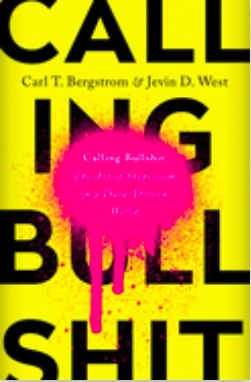
Genre: Adult Nonfiction
Publisher: Random House
Year Published: 2020
Format: Hardcover
Source: Bookshop.org
My Rating: 




“Misinformation, disinformation, and fake news abound and it’s increasingly difficult to know what’s true. Our media environment has become hyperpartisan. Science is conducted by press release. Startup culture elevates bullshit to high art. We are fairly well equipped to spot the sort of old-school bullshit that is based in fancy rhetoric and weasel words, but most of us don’t feel qualified to challenge the avalanche of new-school bullshit presented in the language of math, science, or statistics.
“In Calling Bullshit, Professors Carl Bergstrom and Jevin West give us a set of powerful tools to cut through the most intimidating data. You don’t need a lot of technical expertise to call out problems with data. Are the numbers or results too good or too dramatic to be true? Is the claim comparing like with like? Is it confirming your personal bias? Drawing on a deep well of expertise in statistics and computational biology, Bergstrom and West exuberantly unpack examples of selection bias and muddled data visualization, distinguish between correlation and causation, and examine the susceptibility of science to modern bullshit. We have always needed people who call bullshit when necessary, whether within a circle of friends, a community of scholars, or the citizenry of a nation. Now that bullshit has evolved, we need to relearn the art of skepticism.”
Source: The book description on Bookshop.org
My Review:




The SIFT Method works great for most things, but what if tracing the original source for a claim leads you to some highly technical scientific study? Can non-scientists and non-statisticians really understand the details of that study well enough to determine whether the medical, scientific, or sociological claim based on it is likely to be true?
In Calling Bullshit, Bergstrom and West walk readers through the process of evaluating study results based on the quality of the data that goes in and the soundness of the analysis of the data that comes out. As they point out early on, there’s no need to understand the technical details of the tests run or algorithms used to parse the data to understand whether the study itself is any good.
Bergstrom and West provide lots of lovely and eye catching examples of how data can be manipulated to support false conclusions to drive their lessons home. For example, did you know that from 1999-2007 the age of the Miss American winner correlated directly with the number of people murdered by steam, hot vapors, and hot objects? The correlation falls apart when you consider data from later years, of course, because in real life, there is no actual correlation between Miss America’s age and homicide by steam. Similarly, there is no real relationship between the number of sociology degrees awarded in the U.S. and the rate of death by anticoagulant in the U.S., despite the fact that those two numbers tracked closely for a period of time between 1999 and 2009.
The examples illustrating the principle of garbage in-garbage out when it comes to the methods used to collect data for scientific studies are just as fun to read and easy to understand.
I love this book, and highly recommend it to anyone who wants to be able to analyze a scientific study like a professional without being a scientist, statistician, doctor, or Ph.D of any sort themselves.
NOTE: At the time this review was written the hardback edition of Calling Bullshit was temporarily out of stock on Bookshop.org. However, you can pre-order the paperback edition, which ships April 20, 2021, here. And of course, the e-book is always in stock.
Article: “Comparing the COVID-19 vaccines developed by Pfizer, Moderna, and Johnson & Johnson” (STAT)You may not have time at the moment to read Bergstrom and West’s book, but that’s ok because I think I’ve found a pretty good example of their method being used out in the real world.
Vaccine access is slowly opening up in our area, and with the emergency authorization of the Johnson & Johnson vaccine last week, I found myself asking the question: If I were given a choice of COVID-19 vaccine, which would I choose?
Figuring out the answer to that required taking a closer look at how the media is reporting the relative efficacy of the three vaccines, which is how I stumbled across Helen Branswell’s February 2, 2021 article for STAT comparing the Pfizer, Moderna, and Johnson & Johnson vaccines.
As Branswell reports, when the FDA approved Pfizer and Moderna vaccines for emergency use back in December 2020, they cited the vaccines’ truly stunning 94-95% efficacy against symptomatic COVID-19 after two doses. When the single dose Johnson & Johnson vaccine was undergoing evaluation for the FDA for approval in February 2021 the media reported that it was only 66% effective against moderate to severe COVID-19 illness. At first glance, the Pfizer and Moderna vaccines are clearly superior, right? Why would anyone want to get the Johnson & Johnson vaccine when the Pfizer and Moderna ones already exist?
This is where context really matters. As Branswell points out, the studies establishing the efficacy of the Pfizer, Moderna, and Johnson & Johnson vaccines differ in some important ways. We aren’t comparing apples to apples when we pit the efficacy rates of Johnson & Johnson’s vaccine against those of Moderna and Pfizer. (In my head, I can just see Bergstrom and West nodding their heads sagely. After all, they warned me that this might happen.)
The Pfizer and Moderna vaccine trials were held before more resistant variants were discovered in the U.K., South Africa, and Brazil. At the time Branswell wrote her article, we didn’t yet have the data to know whether Pfizer and Moderna will be equally effective against the newer variants.
In contrast, the Johnson & Johnson vaccine trials include patients infected by the potentially vaccine-resistant B.1.351 variant first detected in South Africa. When you dig deeper into the Johnson & Johnson numbers, you will find hiding behind that top-line 66% efficacy rate an 85% efficacy against severe disease and 100% efficacy against disease severe enough to cause hospitalization and death for all patients in the study, regardless of variant. Even better, that protection came after just one shot.
Suddenly the Johnson & Johnson vaccine looks like a much more viable option. Sure it would be nice not to get symptomatic COVID-19 at all, but not having to worry about being hospitalized or dying if I do catch COVID-19 sounds pretty good to me.
“When people ask me, ‘What can I do now that I couldn’t do before I got vaccinated?’ My answer’s pretty simple: Live. You can live. You don’t have to worry about dying. Let’s build from that.”
– Andy Slavitt, Senior Advisor for the White House Covid-19 Response, in a 24 February 2021 interview with Dr. Bob Wachter on the podcast In the Bubble
Before I took the time to get the context on the Johnson & Johnson vaccine, I was secretly planning to hold out for the more effective Moderna or Pfizer vaccines. But now that I’ve dug into the context around that data, my position has changed. I’m back to planning to take whichever of the three vaccines is available to me first. Please and thank you, I would like to live. This is probably a good thing, since as Branswell points out, COVID-19 vaccines are still quite scarce and whichever vaccine is available at my vaccination site when my turn comes is the one I’ll get.
Comparing the COVID-19 vaccines developed by Pfizer, Moderna, and Johnson & Johnson (StatNews)“Andy Slavitt from Inside the White House,” In the Bubble podcast hosted by Dr. Bob Wachter, 24 February 2021Book: How to Talk So Kids Will Listen & Listen So Kids Will Talk by Adele Farber and Elaine Mazlish
Genre: Parenting
Publisher: Scribner Book Company
Year Published: 2012
Format: Paperbook
Source: Purchase
My Rating: 




“This bestselling classic by internationally acclaimed experts on communication between parents and children includes fresh insights and suggestions, as well as the author’s time-tested methods to solve common problems and build foundations for lasting relationships, including innovative ways to:
Cope with your child’s negative feelings, such as frustration, anger, and disappointmentExpress your strong feelings without being hurtfulEngage your child’s willing cooperationSet firm limits and maintain goodwillUse alternatives to punishment that promote self-disciplineUnderstand the difference between helpful and unhelpful praiseResolve family conflicts peacefully“Enthusiastically praised by parents and professionals around the world, Faber and Mazlish’s down-to-earth, respectful approach makes relationships with children of all ages less stressful and more rewarding.“
Source: The book description on Bookshop.org
My Review:




All of this work I’m doing to learn how to dismantle and neutralize misinformation isn’t worth much if I don’t know how to talk to my kid about it without getting her hackles up.
Our school district is running a workshop series for parents of tweens and teens designed to help us deal with the added stresses created by parenting in a pandemic while our primary backup parent network (teachers, librarians, school counselors, and sports coaches) are no longer available in-person. In one of the break out sessions I listened in awe as a parent described her standard reaction when her stompy, stressed out teen wails about her terrible, no-good, very bad day: “I’m so sorry you feel that way. That sounds so hard.”
I know her exact words, because I made her repeat them so I could write them down. I need scripts like this to short-circuit my own immediate emotional let-me-fix-that-for-you response.
As I was writing down her words, she mentioned that her script came straight out of one of the comic strips in the book How to Talk So Kids Will Listen & Listen So Kids Will Talk. The book was already sitting on my shelves, but I haven’t found time to read it yet.
“Oh, don’t worry about making time to read the whole thing,” she told me. “Most of what I needed from it, I learned by skimming the comics.”
Me being me, I decided to read the comics and have ended up reading the whole thing. In addition to the comics, which take the place of role-playing sessions at the therapist’s office, there are handy reminder cards summing up the lessons in each chapter. The authors recommend that you cut them out and tape them somewhere you will be likely to see them when a relevant parenting challenge comes up. (Sadly this would require defacing a book, so I have merely flagged the pages in my copy and am hoping for the best.)
Although this book is primarily about how to talk with kids without driving them back into their shells, while reading it, I realized that some of the techniques to diffuse emotional situations in Chapter 1 and 2 might also come in handy when I need to have a difficult conversation with an adult I care about but happen to disagree with.
HousekeepingShould you choose to purchase Calling Bullshit or How to Talk So Kids Will Listen and Listen So Kids Will Talk from the Caterpickles Bookstore, you’ll notice that I’ve added a few new sections to my little virtual shop. In addition to existing recommendations for middle grade and elementary graphic novels, picture books, fiction, and nonfiction, I’ve added lists to catalog some of my favorite adult fiction and nonfiction books, as well as books that I believe have made me a better parent. Check it out.
What about you?What have you been reading lately?
Related Links:
Well that sure was something (Caterpickles)
February 17, 2021
Wordless Wednesday: Spring flowers
Personally, I would like this spring to feature a bit more rain, but considering what’s going on in the rest of the country, I’m going to take a moment to appreciate how nice the flowers are here in Northern California.
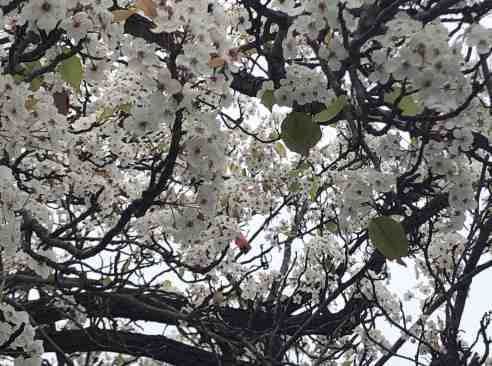 Photo: Shala Howell
Photo: Shala HowellRelated Links:
More Wordless Wednesdays on CaterpicklesFebruary 6, 2021
Sam the Eagle: Bald Eagle, Harpy Eagle, or Shoebill Stork?
Like many Gen Xers I spent my formative years watching the Muppets. In all the hours I spent watching Kermit the Frog trying to corral the Muppet gang into some sort of coherent production, the fact that Sam the Eagle is blue never once made me question whether he was really meant to be an American bald eagle.
For those of you who have put your Muppet days behind you, Sam the Eagle is a tall, frowny, greyish blue bird who regularly condemns his fellow Muppets for frivolity and actions unbecoming of patriotic Americans. Thanks to his crankiness, he is regularly assigned roles such as:
The producer charged with ensuring his fellow actors adhere to their home network’s broadcast standards and practices on the TV series The Muppets A CIA agent tasked with solving a string of burglaries in Muppets Most Wanted A formal and deeply disapproving evening news anchor at WGF news in The Muppets Captain America in the occasional Marvel parody posterSam the Eagle dressed as Captain America for a Marvel parody poster. (Image via the Muppet Wiki)Because Sam the Eagle is so routinely portrayed as the most patriotic and unyielding of all the Muppets, I had simply taken his word for it that he was a bald eagle, with some creative license attached in the form of a George C Scott parody.
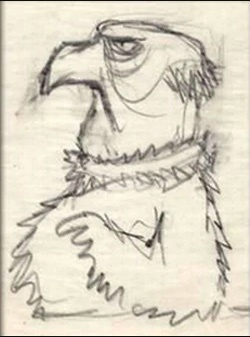 A early design sketch from 1975 for Sam the Eagle by Jim Henson playing up those George C. Scott-inspired jowls. (Via Muppet Wiki, “Sam the Eagle through the years”.)
A early design sketch from 1975 for Sam the Eagle by Jim Henson playing up those George C. Scott-inspired jowls. (Via Muppet Wiki, “Sam the Eagle through the years”.)A quick refresher on George C. Scott (1927-1999) for my younger readers:
An American actor, director, and producer, George C. Scott won, but refused to accept, not one, but two Oscars during his career. The first was for his role as Bert in The Hustler in 1962, and the second for his portrayal of General George S. Patton in the 1970 film, Patton. In explaining his rationale for turning down the awards, Scott reportedly said that he didn’t like feeling that he was competing with other actors. Furthermore, the Oscars were a “demeaning” “two-hour meat parade” and he didn’t want any part of them.
 George C. Scott quote on the Academy Awards/Oscars: “The (Academy Award) ceremonies are a two-hour meat parade, a public display with contrived suspense for economic reasons.” (Image via AZ Quotes)
George C. Scott quote on the Academy Awards/Oscars: “The (Academy Award) ceremonies are a two-hour meat parade, a public display with contrived suspense for economic reasons.” (Image via AZ Quotes)A man who feels that his fellow actors spend too much time in pursuit of things that are frivolous and beneath his dignity? Yep. I totally see the resemblance.
And so I wandered through life, filled with the happy conviction that I knew everything I needed to know about Sam the Eagle.
Exit, pursued by a storkThis happy state continued until last summer, when I saw this guy on Twitter.
Bird Twitter sure looks different at night. (Link to Original Tweet from Jon @giftedrascal. Warning: Jon’s feed is not kid-friendly. I decided to include the entire tweet despite the fireball in Jon’s comment and not just an edited screen capture of it because the video embedded in the tweet really adds a lot. Play it and see what I mean.)I still have a hard time with this being a real bird & not something from 'A muppets fucking nightmare festival' pic.twitter.com/6sHVgvEnjK
— Jon (@giftedrascal) June 8, 2020
My immediate reaction was, as you might expect, terror. It got worse when I did a little Googling and realized that:
this bird really exists — it’s an African shoebill stork it’s almost as tall as my 13-year-old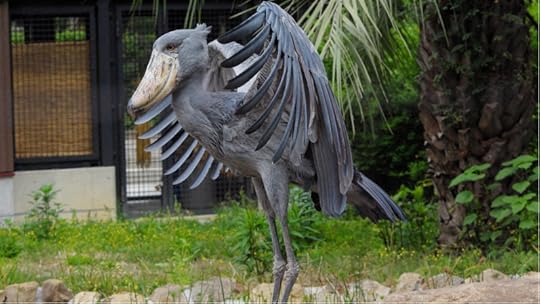 At five feet tall, the shoebill stork is nearly as tall as The Thirteen-Year-Old (when did that happen?). Unlike her, it has a wingspan of up to 8 feet. (Wikimedia Commons image via How Stuff Works).
At five feet tall, the shoebill stork is nearly as tall as The Thirteen-Year-Old (when did that happen?). Unlike her, it has a wingspan of up to 8 feet. (Wikimedia Commons image via How Stuff Works). That concern only grew as I learned more about the African shoebill stork and its predilection for dining on baby crocodiles.
This bird is not to be trifled with.
“That bird looks like a Muppet,” my husband remarked, unfazed.
Now that you mention it…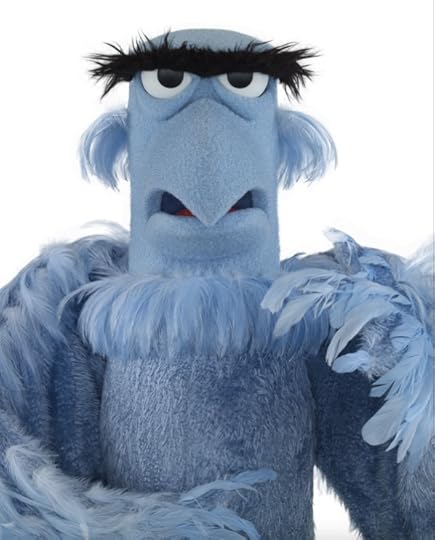 Sam the Eagle. (Image via the Muppet Wiki)
Sam the Eagle. (Image via the Muppet Wiki)Seeing the shoebill made me question everything I thought I knew about Sam the Eagle. While researching the possibility of Sam Eagle being based on something other than a bald eagle, I came across this article from How Stuff Works that posits that Sam the Eagle was actually modeled after the harpy eagle: “The Harpy Eagle: Terrifying Apex Predator or Creepy Halloween Costume?”
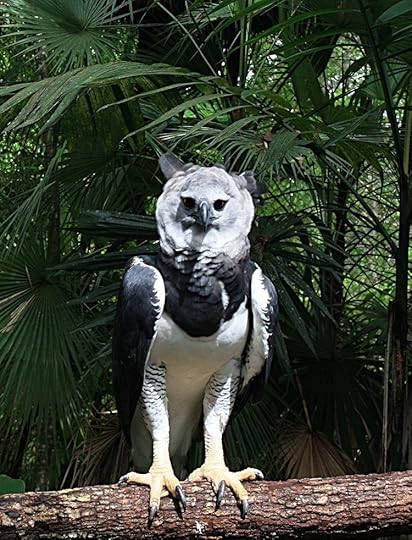 The harpy eagle is the largest eagle in the world. Its talons are bigger than bear claws. (Image by Clément Jacquard, CC BY-SA 2.0 https://creativecommons.org/licenses/by-sa/2.0, via Wikimedia Commons)
The harpy eagle is the largest eagle in the world. Its talons are bigger than bear claws. (Image by Clément Jacquard, CC BY-SA 2.0 https://creativecommons.org/licenses/by-sa/2.0, via Wikimedia Commons)Their argument, while entertaining, essentially boils down to the fact that the harpy eagle is the largest, most judgmental looking eagle on the planet, who, by the way, might also be interested in eating your toddler.
Now, I have no evidence to suggest that Sam the Eagle would ever eat a toddler, but he’s definitely both very large and exceptionally judgmental. Naturally, I’m now questioning everything I thought I knew about Sam the Eagle. There’s only one thing I can possibly do to resolve this: compare and contrast.
Sam the Eagle: bald eagle, harpy eagle, or shoebill stork?Let’s examine the evidence.
Scientific namesAs you know, one of the first things I like to do when deciding whether or not two things are related is to look at their scientific names. Sadly, while it was trivial to find the scientific names for the bald eagle (Haliaeetus leucocephalus), the harpy eagle (Harpia harpyja), and the shoebill stork (Balaeniceps rex), Sam the Eagle doesn’t seem to have ever been given one.
Verdict: No help.
HeightFortunately, it was much easier to find heights for everyone.
American Bald Eagle: Up to 3 feet 2 inches
Harpy Eagle: Up to 3 feet 5 inches
Shoebill Stork: Up to 5 feet
Sam the Eagle: Just over 5 foot 6 inches.
 Sam helpfully poses with Jean Pierre Napoleon in front of a suspect height wall chart in this scene from Muppets Most Wanted. (Image via the Sam the Eagle Muppet Wiki.)
Sam helpfully poses with Jean Pierre Napoleon in front of a suspect height wall chart in this scene from Muppets Most Wanted. (Image via the Sam the Eagle Muppet Wiki.)Verdict: Height-wise, Sam the Eagle is most like the shoebill stork.
ColoringAmerican Bald Eagle: White and brown
Harpy Eagle: Grey, black, and white
Shoebill Stork: Greyish blue
Sam the Eagle: Blue
Verdict: Again, Sam the Eagle is most like the shoebill stork.
Beak shapeAmerican Bald Eagle: Thick, yellow, and pointy.
 Bald Eagle. (Image: US Fish and Wildlife Service/Mike Lockhart, public domain via Wikimedia Commons)
Bald Eagle. (Image: US Fish and Wildlife Service/Mike Lockhart, public domain via Wikimedia Commons)Harpy Eagle: Skinny (relative to the harpy’s face), black, and sharp
Shoebill Stork: Thick, beige, often described as being shaped like a Dutch clog, hence the name shoebill.
Sam the Eagle: Thick, blue, and pointy
Verdict: If you ignore the color and focus on its shape relative to his face, Sam the Eagle’s beak looks most like a bald eagle’s.
DietAmerican Bald Eagle: Fish, mammals, gulls, and waterfowl. Will steal food from other birds, scavenge, or eat garbage.
Shoebill Stork: Fish including lungfish, tilapia, and catfish; frogs; and reptiles like snakes, monitor lizards, and baby crocodiles
Sam the Eagle: I remember Sam the Eagle singing about how tasty chicken hawks were once, but I don’t actually remember him eating anything. Neither was I able to find anything in his Wiki about food. However, in January 2020, Walt Disney World announced that it would open a Regal Eagle BBQ Smokehouse at Epcot, hosted by Sam the Eagle. Presumably they would know. Therefore, I conclude that BBQ is Sam the Eagle’s favorite food.
 Concept art for the Regal Eagle Smokehouse at Walt Disney World’s Epcot Park. (Image via Disney Parks Blog)
Concept art for the Regal Eagle Smokehouse at Walt Disney World’s Epcot Park. (Image via Disney Parks Blog)Verdict: The only bird on this list that sounds like it might have eaten BBQ at some point is the bald eagle, with its propensity for eating garbage. If some of that garbage was acquired at a former picnic site, it likely would have included BBQ. So I guess, most like the bald eagle in diet?
Family StructureAmerican Bald Eagle: Thought to be monogamous, although bald eagles have been known to take a new mate after their previous one dies. Have 1-3 nestling eaglets at a time, which remain with their parents for between 17-24 weeks while they learn to fly and, presumably, hunt for themselves. Generally, bald eagles reproduce once a year, although in southern regions may lay a replacement clutch of eggs if something happens to their first set during incubation.
Harpy Eagle: Mate for life and raise one chick every two to four years. When a new chick is born, it remains in the nest for 6 months. The parents will continue feeding that chick for up to 10 months after it leaves the nest.
Shoebill Stork: According to The Freaky and Formidable Shoebill Stork is One Strange Bird article on How Stuff Works, shoebill storks are monogamous and work together to build their floating barge-like nests and raise their young. Although the female will lay up to three eggs per clutch, only the eldest survives. The first shoebill in the clutch to hatch eats the others.
Sam the Eagle: According to the Family Life section on the Sam the Eagle Wiki, Sam the Eagle has an ex-wife named Eunice and two kids who were in college as of 2011. Neither child is currently speaking to him, perhaps due to the deeply disapproving lecture he undoubtedly gave them when he learned that his son planned to become a taxidermist and that his daughter was dating an owl.
In Summary: As far as the number of young goes, Sam the Eagle is most like the bald eagle. His desire to have an ongoing involvement in his kids’ lives after they leave the nest sounds like the harpy eagle. The shoebill stork’s home life is just horrifying and I am not going to make any attempt to link Sam the Eagle to it.
Verdict: Inconclusive, although I do question whether the son’s interest in taxidermy might indicate a latent bald eagle-like interest in carrion.
Legs and feetAmerican Bald Eagle: Bright yellow legs and feet, with thick brown feathers on their thighs.
Harpy Eagle: Powerful yellow legs and feet, with black and white feathers on the thighs.
Shoebill Stork: Spindly, skinny long legs. Known to poop on their upper thighs in an effort to keep them cool.
Sam the Eagle: Thick yellow feet, with blue feathers on the thighs.
Verdict: Sam the Eagle’s feet are much more like an eagle’s feet than a stork’s. Which eagle is less clear. This portrait of Sam the Eagle dressed as Sam Arrow in Muppet Treasure Island makes me think that proportionately, Sam the Eagle’s feet are sized more like the harpy eagle than the bald eagle.
 Sam the Eagle in his role as Sam Arrow in Muppet Treasure Island. (Image via Sam the Eagle Muppet Wiki)So is Sam the Eagle a bald eagle, a harpy eagle, or a shoebill stork?
Sam the Eagle in his role as Sam Arrow in Muppet Treasure Island. (Image via Sam the Eagle Muppet Wiki)So is Sam the Eagle a bald eagle, a harpy eagle, or a shoebill stork?I’m going with yes. He seems to have at least a few things in common with all three, although I have no doubt he would find their behavior in the wild to be completely appalling.
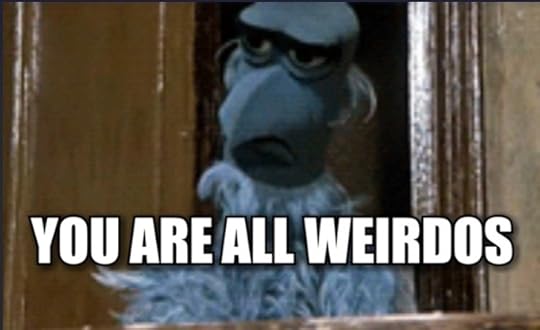 Sam the Eagle, as seen in The Great Muppet Caper: “You are all weirdos.” (Image via Templar Prophet on Imgur. See Sam the Eagle perform this quote live on YouTube here.)Related Links: George C. Scott Obituary (BBC)Sam the Eagle: Through the Years (Muppet Wiki)Sam the Eagle (Muppet Wiki)The Freaky and Formidable Shoebill Stork is One Strange Bird (How Stuff Works)The Harpy Eagle: Terrifying Apex Predator or Creepy Halloween Costume (How Stuff Works)Largest eagles in the world are so big their talons are bigger than bear claws (My Modern Met)Harpy Eagle (American Bird Conservancy)National Eagle Center FAQBald Eagle Identification (All About Birds, The Cornell Lab) The American Eagle Foundation
Sam the Eagle, as seen in The Great Muppet Caper: “You are all weirdos.” (Image via Templar Prophet on Imgur. See Sam the Eagle perform this quote live on YouTube here.)Related Links: George C. Scott Obituary (BBC)Sam the Eagle: Through the Years (Muppet Wiki)Sam the Eagle (Muppet Wiki)The Freaky and Formidable Shoebill Stork is One Strange Bird (How Stuff Works)The Harpy Eagle: Terrifying Apex Predator or Creepy Halloween Costume (How Stuff Works)Largest eagles in the world are so big their talons are bigger than bear claws (My Modern Met)Harpy Eagle (American Bird Conservancy)National Eagle Center FAQBald Eagle Identification (All About Birds, The Cornell Lab) The American Eagle Foundation
January 15, 2021
First Impressions: Punching the Air by Ibi Zoboi and Yusef Salaam
NOTE: This post contains affiliate links to Bookshop.org, an online bookstore that provides financial support to local independent bookstores. By the time I wrote this post, Bookshop.org had already raised $10.8m for local bookstores. If you use the links in this post to purchase a book or two on Bookshop.org, I’ll earn a commission on your book purchase, as will your preferred independent bookshop. You can also find these books in the new Caterpickles Bookstore. Regardless of whether you use my links or visit the Caterpickles Bookstore, I’m glad you spent part of your day reading Caterpickles. Learn more about Affiliate Links, the Caterpickles Bookstore, and why I decided to become a Bookshop.org Affiliate.
In the Before Times, when parent volunteers were still allowed at my daughter’s middle school, I used to spend every Wednesday working in the school library doing a variety of jobs, only some of which have translated well to remote work. Fortunately, preparing new books to go into circulation is one of them.
I love this job, because our librarians have excellent taste in books, and each month’s order invariably includes several great books that I haven’t heard of yet, like Punching the Air by Ibi Zoboi and Yusef Salaam.
First Impression: Punching the Air by Ibi Zoboi and Yusef Salaam
Genre: YA Novel in Verse
Publisher: Balzer & Bray/Harper Teen
Year Published: 2020
Format: Hardcover
Source: Library
Accolades: New York Times and USA Today Bestseller, Publishers Weekly Best Book of the Year, Shelf Awareness Best Book of the Year, School Library Journal Best Book of the Year, New York Public Library Best Book of the Year
Book Summary: Punching the AirWhy I’m Interested“From award-winning author Ibi Zoboi and prison reform activist Yusef Salaam of the Exonerated Five comes a powerful YA novel in verse about a boy who is wrongfully incarcerated. Perfect for fans of Jason Reynolds, Walter Dean Myers, and Elizabeth Acevedo.
“The story that I thought
was my life
didn’t start on the day
I was born“Amal Shahid has always been an artist and a poet. But even in a diverse art school, he’s seen as disruptive and unmotivated by a biased system. Then one fateful night, an altercation in a gentrifying neighborhood escalates into tragedy. ‘Boys just being boys’ turns out to be true only when those boys are white.
“The story that I think
will be my life
starts today“Suddenly, at just sixteen years old, Amal’s bright future is upended: he is convicted of a crime he didn’t commit and sent to prison. Despair and rage almost sink him until he turns to the refuge of his words, his art. This never should have been his story. But can he change it?
“With spellbinding lyricism, award-winning author Ibi Zoboi and prison reform activist Yusef Salaam tell a moving and deeply profound story about how one boy is able to maintain his humanity and fight for the truth, in a system designed to strip him of both.”
Book description from Bookshop.org
The last novel in verse I read was Eugene Onegin by Alexander Pushkin in 2013. Let’s just say, it did not turn me into a fan of the genre. Perhaps it was the fact I read Eugene Onegin in translation, or perhaps it was that I am not that familiar with Russian society in the 1830s, but after finishing Eugene Onegin I was left with the impression that novels in verse are fine but poems are kind of a contrived way to tell a story.
While preparing this week’s crop of books, I had a chance to read excerpts from Ibi Zoboi and Yusef Salaam’s Punching the Air. My accidental glimpses of their writing is making me reconsider. Zoboi and Salaam’s poems are immediate and thought-provoking in a way Eugene Onegin never was. Consider “Gray Suit,” one of the poems describing Amal’s trial.
GRAY SUIT
Umi told me to wear a gray suit
because opticsBut that gray didn’t make me any less black
My white lawyer didn’t make me any less blackAnd words can paint black-and-white pictures, too.
Maybe ideas have their own eyes
separating black from white as if the world
is some old, old TV showMaybe ideas segregrate like in the days of
Dr. King, and no matter how many marches
or Twitter hashtags or Justice for So-and-Soour mind’s eyes and our eyes’ minds
“Gray Suit” from Punching the Air by Ibi Zoboi and Yusef Salaam, p. 9.
see the world as they want to
Everything already illustrated
in black and white
I would read the heck out of a novel written in poems like that.
What about you?What’s on your TBR pile?
Related Links:
Book Reviews: I Want My Hat Back and A Bedtime for Bear (Caterpickles)What I’ve been reading in between bouts of doom-scrolling the news (Caterpickles)
January 13, 2021
Funny Things My Mom Says, As Recorded by The 13-Year-Old
Longtime readers of Caterpickles will remember that in the very early days of the blog, I used to devote Saturday mornings to funny things my daughter said.
Case in point: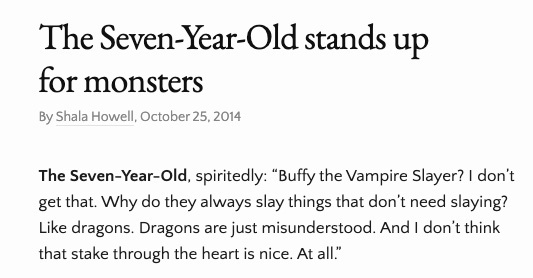 Post from October 25, 2014 documenting one of the very many funny things my daughter said that year.
Post from October 25, 2014 documenting one of the very many funny things my daughter said that year. As she got older, she asked that I stop doing that, so I did.
However, I am pleased to report that given the heaviness of our current news environment, The Thirteen-Year-Old has given me permission to post a special illustrated edition of “Funny Things My Mom Says As Recorded by The Thirteen-Year-Old.”
Context: Lately, in an attempt to channel Canelo’s still fairly boundless energy in a more positive and less bite-y direction, I’ve been playing with him in the evenings. Naturally I talk to him while I’m doing this. The Thirteen-Year-Old, apparently, finds this absolutely hilarious, and has been keeping a list of “Funny Things My Mom Says.” I stumbled across it while cleaning the hall bookcase earlier this week.
Here are a few of my daughter’s favorites from the list.
1: “Dude, you’re a waterbed for a mouse.” (Photo: Shala Howell)2: “This is not how you play cat and mouse. This is how you play horse.”
(Photo: Shala Howell)2: “This is not how you play cat and mouse. This is how you play horse.”
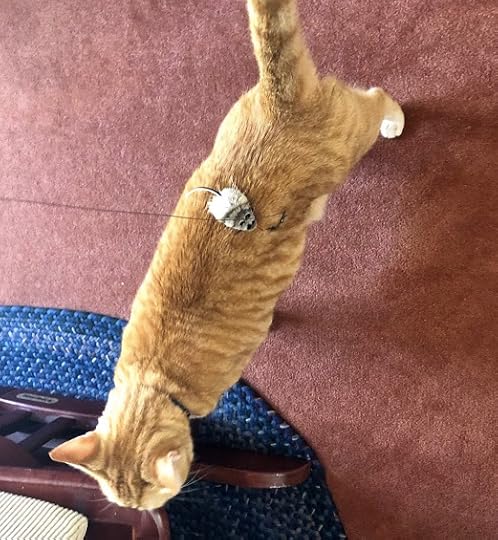 (Photo: Shala Howell)3: “Hey! That’s my yarn bucket!”
(Photo: Shala Howell)3: “Hey! That’s my yarn bucket!”
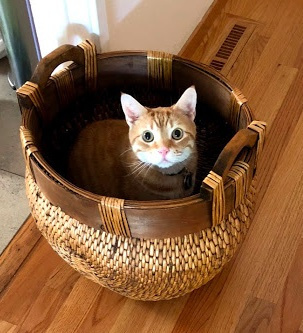 Photo: Shala Howell
Photo: Shala HowellFor the record, I’ve been trying in vain to keep Canelo out of my yarn since he was a kitten. It’s one of the reasons I always wash my blankets before I give them away.
 Photo: Shala Howell
Photo: Shala HowellI am never going to train this cat out of his love of knitting in all of its stages. Which is no doubt why Michael gave me a fabric duffel bag with a zip top for me to use to corral the yarn for my various projects instead.
Take care of yourself today.
More Funny Things My Daughter Says:
The Seven-Year-Old stands up for monsters (Caterpickles)Never go to war with a cat (Caterpickles)My other car is a batmobile (Caterpickles)Weekend at Caterpickles (Caterpickles)January 7, 2021
Well, that sure was something
Before I resume business as usual here on Caterpickles, I’d like to take a moment to acknowledge what an utterly disorienting moment we are living through as a country. My entire life, I have witnessed one Vice-President after another calmly preside over Congress as they go through the formality of tallying the votes of the election from the preceding November. Even when some of them–Gore in my lifetime, Nixon just before it– were former Presidential candidates who were surely disappointed in the results.
Pence, to his credit, did the same yesterday. I expected that. What I didn’t expect was for our current President, having exhausted all legal remedies to overturn the election in the courts, to incite a mob to attack Congress and his own Vice-President while they were in the process of tallying the state-certified vote. It was astonishing and horrifying.
Like many of you, I have been reading a lot today about yesterday’s events in an attempt to understand what happened. I am not interested in the man in the buffalo costume or the folks in military garb who were obviously there for the insurrection. I’m interested in Elizabeth from Knoxville, who was captured on a video that quickly went viral, and who was so clearly confused about why the Capital Police maced her when all she’d done was storm the Capitol to have a little revolution. I mean, what did she think would happen? The Capitol Police reaction seemed predictable, and yet Elizabeth failed to predict it. Her privilege blinded her.
For all the scenes of rioters smashing furniture, breaking glass, and ransacking offices, I have found just as many stories of people like Elizabeth. In his article for The Nation, “Madness on Capitol Hill”, Andrew McCormick described the atmosphere yesterday as “Part insurrection, part happy hour.” Merchants sold t-shirts and hats for $15. Trump supporters queued up at liquor stores or stopped by bars for margaritas on their afternoon out. As curfew approached last night, I watched streams of casually dressed people on CNN peacefully walking away from the Capitol grounds even as hundreds of their fellow Trump supporters continued to scale the walls and swarm the Capitol steps.
Watching and reading reports of the interviews with the riot-adjacent participants in yesterday’s events, I am struck by the fact that many of these people have trouble discerning the difference between reality and the show. At the very least they are operating on a completely different set of facts.
How did that happen? How can I, as a parent, teach my daughter to guard against it?
For that matter, how can I guard against it myself?
Many of the tricks I was taught as a child to guard against misinformation have been rendered obsolete. After all, it’s not hard to find the same fact in at least three unrelated online sources in the age of copy and paste. To make matters worse, social media algorithms are tuned to feed us more of the content we engage with. I try to fool it by following folks in a wide variety of fields and on all sorts of political aisles, but even so, I’m naturally more inclined to read some articles more carefully than others. My Twitter feed right now is both super interesting and personally quite validating, which undoubtedly means I’ve been successfully siloed despite my best efforts, and it’s time to curate the people I follow again to shake things up.
In reflecting on yesterday’s events, it occurs to me that we all need to think more carefully about the sources we rely on, why we trust them, and whether they have earned that trust.
In line with that, I am going to try to be a little more transparent about the sources I use to answer my various odd ball questions here at Caterpickles. Instead of simply providing a link to the sources I use for various posts, I will work a little harder to make my reasons for choosing that source more transparent. That may mean telling you why I picked a particular source. Every once in a while, it could also mean telling you about a source I chose not to use, and why I chose not to use it.
What about you?
Did you watch the news yesterday? What did you think?
Related Links:
Election 2020 is upon us. Do you have a plan to vote? (Caterpickles)“What’s so important about fostering curiosity anyway?” (Caterpickles)
January 1, 2021
Happy New Year!
Well, that’s a wrap on 2020. Someone on Twitter commented on how living through the pandemic made them understand the roughly decade-long party that broke out in the Roaring Twenties after WWI and the 1918-19 influenza epidemic.
Similarly, I have a new appreciation for the complex layers of emotion lurking in pictures like this one:
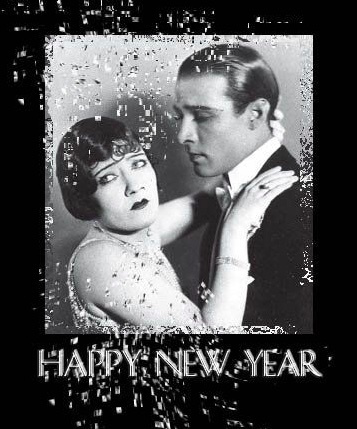 Holiday card featuring a vintage photo of the saddest flapper I have ever seen. (Via Pinterest, of course)
Holiday card featuring a vintage photo of the saddest flapper I have ever seen. (Via Pinterest, of course)Those eyes. She’s trying so hard to put the horrors of 1918 behind her, but can’t quite yet.
Like this sad flapper, I am greeting 2021 with a heartfelt plea that the vaccine will be safe, effective, and distributed both efficiently and equitably; that folks who have lost their jobs can return to work safely soon; that the small businesses that give our world such interest and character will survive; that our frontline workers can get a much needed paid vacation; that we can see my beloved and dearly missed extended family and friends in person again without risking their health or ours in the process; and that all of us will remember how to live as a community of caring and capable neighbors.
Fingers crossed.



